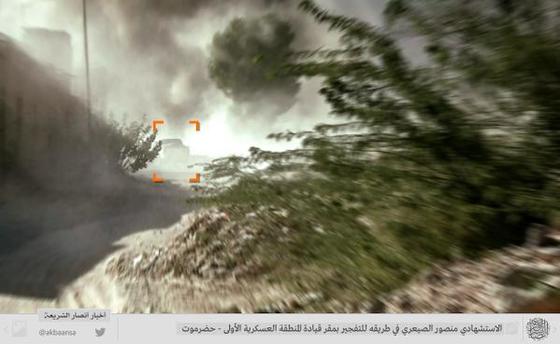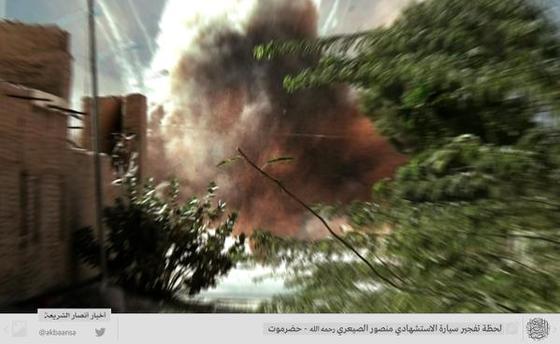Al Qaeda in the Arabian Peninsula (AQAP) carried out a double suicide bombing early this morning at the First Military Command base in Seyoun, the capital of Yemen’s eastern Hadramout province. Yemeni security sources reported that two attackers detonated separate vehicle-borne improvised explosive devices (VBIEDs) at the base, killing at least five soldiers and wounding between four and eight others.
A Twitter account affiliated with AQAP promptly claimed credit for the bombings and alleged that “tens” of soldiers were killed in the attacks. Although Yemeni security officials indicated that soldiers had prevented the explosives-laden vehicles from entering the facility, AQAP claimed that one car bomb exploded at the base’s gate and the other detonated inside the compound.
AQAP identified the first suicide attacker as Humam al Qarqa al Awlaki, also known as Julaybeeb al Awlaki. According to the group’s statement released this morning, Awlaki detonated a Suzuki Vitara laden with half a ton of explosives at the gate of the base at around 8:40 a.m. About two minutes later, the second suicide attacker, Nasser bin Ganam al Si’ri, also known as Mansour al Si’ri, detonated a Toyota Hilux carrying 1.25 tons of explosive material inside the command headquarters, allegedly killing “tens” of soldiers and disabling a number of military vehicles.
AQAP stated that its fighters had been monitoring the base prior to the operation and noted that a military convoy that included high-ranking officials had entered the facility about 30 minutes before the attacks.
Yemeni officials told Arabic news outlets that a military truck was also attacked last night in the city of al Shihr, about 150 miles south of Seyoun. Two soldiers were killed and one wounded in the incident, according to officials.
An AQAP statement released today alleged that its fighters attacked the military truck with an improvised explosive device (IED) at 8:30 p.m. on Dec. 8 at the western entrance to al Shihr, killing three soldiers and wounding other passengers. The statement also asserted that soldiers from a nearby barracks began firing in the area “randomly” for over an hour after the attack, ostensibly damaging a nearby mosque and several “houses of Muslims in the area.”
Bombings in Sana’a
Today’s double suicide attack in Hadramout follows a day of AQAP bombings in Sana’a targeting the residences of Shiite Houthi rebel leaders in the city. The jihadist group said that its fighters carried out three nearly identical twin bombing attacks on the morning of Dec. 8 at the residences of Abd al Ilah al Sharqi, Mohammad Dhayf Allah, and a third unnamed Houthi leader, killing a total of 15 Houthis and wounding 36.
Local media outlets reported that five IEDs exploded in several locations in Sana’a on Monday morning, injuring a total of eight people. Two of the IEDs reportedly detonated in the al Sha’ub district of Sana’a at the home of a local carpenter and overt Houthi supporter, Abdul Hamed Dhayf Allah. The first bomb exploded at 6:00 a.m. and the second, attached to a car parked outside the house, went off about 20 minutes later, reportedly injuring eight local residents.
An officer from the Criminal Investigation Bureau in Sana’a claimed that a third IED exploded a short time later at the house of local Houthi leader Abdullah al Sharafi in the capital’s Hasaba district. In addition, two IEDs detonated in the al Sayah neighborhood of Sha’ub district yesterday morning, with apparently no injuries.
According to a statement released by AQAP today, its fighters staged three identical bombing operations at the residences of Houthi leaders, each comprised of two staggered explosions at each site.
In the jihadist group’s account, the first attack took place at 6:00 a.m. at the residence of Houthi politician Abd al Ilah al Sharqi, where AQAP fighters detonated a rigged motorbike parked outside the house, damaging the building’s facade as well as six vehicles. As Houthis gathered at the scene of the initial explosion, AQAP claimed it detonated a second and more lethal IED comprised of 13 kilograms of TNT and 370 pieces of shrapnel. According to the jihadist group’s statement, eight Houthis were killed and 14 others were wounded in the secondary attack.
AQAP also stated that it carried out essentially the same operation at the residence of Houthi leader Mohammad Dhayf Allah, remotely detonating the first IED at 6:15 a.m. and the second, a five-kilogram explosive, at 6:30 a.m. The jihadist group also stated that its fighters reenacted this scenario a third time at the house of an unnamed Houthi leader, claiming that seven Houthis were killed and 22 injured in these two attacks.
AQAP has already claimed credit for a total of 25 terrorist attacks throughout Yemen against both Houthi and military targets since Dec. 1, including today’s bombing at the First Military Command base in Hadramout. Eight of these attacks (about 30 percent of all AQAP attacks this month) have been directed at the Yemeni military, mostly in Yemen’s southern and eastern provinces.
The remaining operations, with the exception of the Dec. 3 bombing at the residence of the Iranian ambassador to Yemen, have been directed at Houthi military positions and/or individual Houthi leaders or their alleged supporters. The majority of these attacks (7) took place in Sana’a, whereas other operations were conducted in Ibb and Baydah provinces.
AQAP has been battling its traditional local enemy, the Yemeni military, and its rising nemesis, the Shiite Houthi rebels, while still managing to threaten the US. On Dec. 4, the jihadist group released a video featuring hostage Luke Somers, threatening to kill the American photojournalist if the US government did not give in to various demands. On Dec. 6, AQAP killed Somers as well as a South African hostage during a rescue attempt by US forces in Shabwa. And two weeks ago, AQAP claimed responsibility for a double IED attack at the US Embassy in Sana’a.
The following photos were released by AQAP along with the statement regarding today’s attack at the First Military Command base in Hadramout:
 The first suicide attacker – Humam al Qarwa al Awlaki
The first suicide attacker – Humam al Qarwa al Awlaki
 The second suicide attacker, Nasser bin Ghanam al Si’ri
The second suicide attacker, Nasser bin Ghanam al Si’ri
 This image purports to show the second suicide attacker approaching the base
This image purports to show the second suicide attacker approaching the base
 This image purports to show the detonation of the second VBIED
This image purports to show the detonation of the second VBIED







